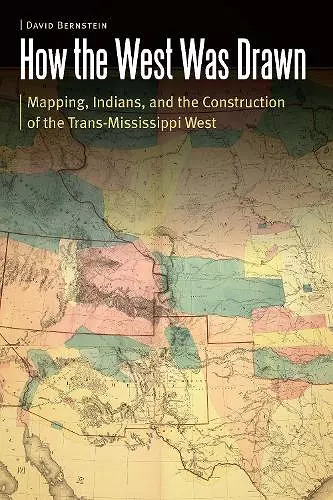How the West Was Drawn
Mapping, Indians, and the Construction of the Trans-Mississippi West
Format:Paperback
Publisher:University of Nebraska Press
Published:1st Mar '21
Currently unavailable, and unfortunately no date known when it will be back

How the West Was Drawn explores the geographic and historical experiences of the Pawnees, the Iowas, and the Lakotas during the European and American contest for imperial control of the Great Plains during the eighteenth and nineteenth centuries. David Bernstein argues that the American West was a collaborative construction between Native peoples and Euro-American empires that developed cartographic processes and culturally specific maps, which in turn reflected encounter and conflict between settler states and indigenous peoples.
Bernstein explores the cartographic creation of the Trans-Mississippi West through an interdisciplinary methodology in geography and history. He shows how the Pawnees and the Iowas—wedged between powerful Osages, Sioux, the horse- and captive-rich Comanche Empire, French fur traders, Spanish merchants, and American Indian agents and explorers—devised strategies of survivance and diplomacy to retain autonomy during this era. The Pawnees and the Iowas developed a strategy of cartographic resistance to predations by both Euro-American imperial powers and strong indigenous empires, navigating the volatile and rapidly changing world of the Great Plains by brokering their spatial and territorial knowledge either to stronger indigenous nations or to much weaker and conquerable American and European powers.
How the West Was Drawn is a revisionist and interdisciplinary understanding of the global imperial contest for North America’s Great Plains that illuminates in fine detail the strategies of survival of the Pawnees, the Iowas, and the Lakotas amid accommodation to predatory Euro-American and Native empires.
"The book's well-sourced revisionist examination of history through the eyes of both Euro- and Native Americans, and the influence of indigenous knowledge on cartography, is compelling, and thus it is a worthy addition to any historical examination of the Trans-Mississippi West."—Brian Croft, Nebraska History
"Bernstein provides an interesting read on the importance of cartography and the cultural construction of the Trans-Mississippi West that is well worth reading for historians, cartographers, and cultural geographers, specialists and nonspecialists alike."—Ellen R. Hansen, Kansas History
"David Bernstein's book adds fresh nuance to our understanding of the American West, particularly in regard to the creation of maps and boundaries."—Matthew K. Guske, Chronicles of Oklahoma
"By examining the motives and process of mapmaking, Bernstein restores historical agency to the Pawnee and other tribes."—R. Dorman, Choice
"Mapping does not stop. We find today the same kind of negotiated, contested, politically charged mapping process happening around the world as Bernstein finds in the nineteenth-century American West. Thus, another important contribution of Bernstein's work is its potential to shape how we think about and engage in mapping today."—John Krygier, South Dakota History
"Bernstein's interesting and scholarly study discusses how the westward movement made maps necessary administrative mechanisms."—Lynn Bueling, Roundup Magazine
"David Bernstein's How the West Was Drawn offers an important reassessment of the cartographic history of the American West, exploring how Plains Indians—specifically, Iowas, Pawnees, and Lakotas participated in the mapping and remapping of the region in the late eighteenth and nineteenth centuries."—Alessandra Link, Environmental History
"Throughout the volume, Bernstein not only makes a convincing argument, but he also corrects some of the problematic ideas scholars have advanced or embraced over the years. This is a well-researched book. The author draws from manuscript sources at the Kansas Historical Society, the Missouri History Museum, the National Archives, and the Newberry Library, among other repositories, not to mention newspapers, government documents, Native American records, and other published primary sources. . . . In addition, it would be a mistake not to mention and commend the book’s excellent selection of 46 map images. . . . Bernstein does an excellent job integrating these maps into his analysis and the University of Nebraska Press should be commended for their investment in this incredible level of illustration. This is a book that will work well in graduate seminars on Native American history, the history of the antebellum U.S., the history of cartography, and colonialism. Anyone interested in space and place in the North America would do well to read this book."—Evan Rothera, Reviews in History
"Bernstein provides important tools for thinking about maps in complex ways. He carefully draws attention to the multifaceted processes and power involved in their construction, which, in turn, opens up many avenues for understanding how and why U.S. expansion developed as it did."—Rebekah M. K. Mergenthal, Annals of Iowa
"Bernstein not only engages the historiography of Native America and cartography, but also joins a growing corpus that reassesses U.S. expansion from the point of view of those on the ground who would subvert and offer contingencies to the path of empire. Bernstein draws these insights from a well executed study centered around the Pawnees of the early nineteenth century who occupied the region that would become the states of Kansas and Nebraska."—Jimmy L. Bryan Jr., Western Historical Quarterly
ISBN: 9781496224927
Dimensions: unknown
Weight: unknown
330 pages